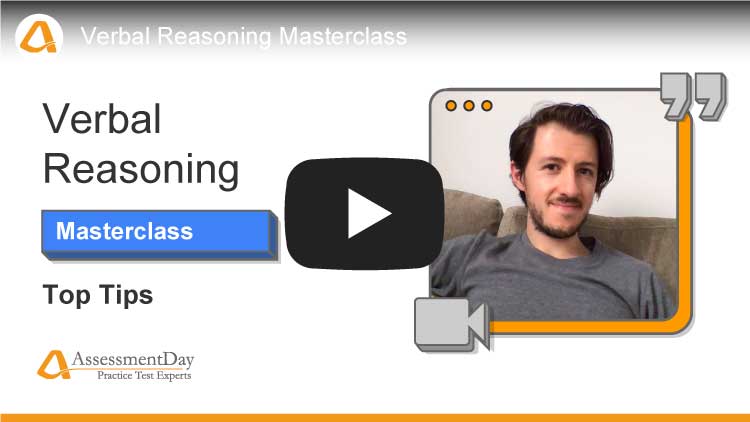How To Answer Verbal Reasoning Test Questions - Tips and Advice
Verbal reasoning test tips and advice to help you understand verbal reasoning tests. Use this analysis of an example question to gather how questions work along with our top tips.
Page contents:
Jump to:Quick verbal reasoning re-cap
We cover more extensively what verbal reasoning tests are with examples and video tutorials on our verbal reasoning page. Be sure to check that out if you haven't, but for now let's outline what they are before diving into the analysis and advice.
Verbal reasoning tests are designed to measure your powers of verbal comprehension, reasoning, and logic - all done through the understanding of language.
You will be tested on whether you jump to conclusions or whether you appreciate the limitations of a statement.
By far the most common form of verbal reasoning test is one with a given passage of text, and you are asked to verify the validity of questions or statements about said passage. Questions regarding the passage of text reflect our ability to comprehension the logical contingents of language.
For example, there is a difference between: A. the fox has appeared in the street, and B. it appeared that the fox was in the street.
In example A, the language means that the fox is in the street. It is demonstrable and true by definition as it is intrinsic in the language. In example B, the fox could have been in the street by the logic of the language. It is not demonstrable that it was there. This crucial difference, one where it is a demonstrable truth, by definition, and one where it could have been, likely perhaps but not a truth, is important to remember. It is reasoning skills such as this that is the entire exercise of the verbal reasoning test.
Analysing an example verbal question
Here is an example verbal reasoning question, specifically designed to be a standardised question for such a test. This breakdown will help you understand how to tackle a verbal reasoning question. It is less than 800 characters long (a common feature) with some assertive clauses, as well as ambiguous clauses:

We are going to look at one easy question and one difficult question to compare and contrast the spectrum of complexity for a verbal reasoning question set. For each statement, look at the passage of text above and decide if the statement is: true, false or cannot say. The answers will be below each question.
Easy Question: Chemical improvements have led to the construction of longer-lasting structures.
Line 4 states that chemical improvements in concrete have increased their lifespans. Therefore, it is definitely true.
As you can see, this question is relatively straight forward as the answer is clearly located within the text passage. Thus, we would say this is an easy question in terms of complexity.
Hard Question: Developing countries have produced constructions following the major improvements in the chemistry of concrete mixtures.
Line 4 states that chemical improvements in concrete have enabled the ease of manufacturing. Line 6 then states that concrete construction has thus become more affordable for many improving economies. The word many here gives ambiguity because it suggests that concrete construction has not become more affordable to some improving economies. Line 7 states that this means developing countries are able to produce more sophisticated construction. It does not say whether this means more or less buildings. Though it is suggested by the ease of manufacturing, and the more affordable cost, that it would be more rather than less. Nevertheless, we are still confronted with the ambiguity of this not applying to all developing countries, therefore, true or false are out of the question. It answer must be 'cannot say'
As you can see, this question is challenging given the ambiguity of the clauses as well as the divergence of logic. It is much more complex than our easy question.
Our verbal reasoning test tips
Now that we've analysed an example question, it's time to learn some of our tips specifically tailored to help you pass verbal reasoning tests.
You can watch our video below where Ben talks through some verbal reasoning tips, and also read through the tips below:

Know what the possible answers mean
The trick to verbal reasoning questions is to always remember the strict meaning of the three possible responses. They are:
- True means the statement follows logically given the information contained within the passage.
- False means the statement cannot logically follow given the information contained within the passage.
- Cannot Say means you are not given enough information in the passage to decide.
The key to all of these is you must consider ONLY the information given in the passage.
Take everything literally
A robot would do well in verbal reasoning tests since it will not take anything for granted, it will not make unjustified assumptions, and it will be literal almost to the point of being obtuse.
Take every word literally and remember you are asked to answer the questions based on only what is given in the passage. Think to yourself "Am I being told this statement is absolutely 100% true or being told this is absolutely 100% false?" If neither, the correct answer must be Cannot Say. The statements are True or False only if the information in the passage tells you as much. Re-read the text a few times to ensure you are not making any assumptions.
Practice some questions for yourself and check our solutions. You will be caught out of you start making assumptions about information not explicitly given in the text passage.
Time allocation for verbal reasoning questions
For verbal reasoning questions, your approach to time allocation should be slightly different to that for numerical questions. Again, have a quick scan ahead to see how many questions the passage relates to; it is typically three to four. With verbal reasoning tests however, the bias of time spent reading the passage should be towards the first reading and understanding. Then when it comes to answering a particular question, you know where to check the wording/meaning of the passage in order to answer the question. So, for a typical set of three questions, the time plan might look something like this:
- 3 seconds scanning ahead to see how many questions the passage relates to;
- 60 seconds reading and understanding the passage.
- 5 seconds reading and understanding the first question;
- 35 seconds answering the question by finding the relevant sections in the passage.
- 5 seconds reading and understanding the second question;
- 35 seconds answering the question by finding the relevant sections in the passage.
- 5 seconds reading and understanding the third question;
- 35 seconds answering the question by finding the relevant sections in the passage.
That’s about three minutes to answer three questions, which is about right for a typical set of three verbal reasoning questions.
Learn from your mistakes
When you're taking practice tests and you get questions wrong, invest time into understanding why that was the case.
Taking the tests and not studying the answers and answer explanations will not improve your test performance as much due to you not understanding why you made those errors. Learning from your mistakes is essential to improving. Our practice tests come with solutions which explain why the answer is correct.
Lots of practice
Familiarise yourself with this test type by taking several practice tests. Practicing will help improve your analytical skills. You will become familiar with how passages are written and what to look for. If these tests seem confusing or you don't feel confident tackling these types of questions, then it's vital you make yourself prepared with practice tests.
Practise free verbal reasoning tests
We have taken a look at the difference in complexity between verbal reasoning questions, and analysed the way that the verbal reasoning logic works. Now let's put into practice by taking our free verbal reasoning test, designed to emulate the real thing.
Create a free account below and get access to our free verbal reasoning tests.
Start practising quality tests with a free account
Practice makes perfect
- Learn from detailed solutions
- Track your progress

Additional psychometric test resources
We have lots of specialised and specific psychometric test advice waiting for you. Simply navigate over to our resources section where you can find all of our test advice, or click on one of the following links you may find useful:
